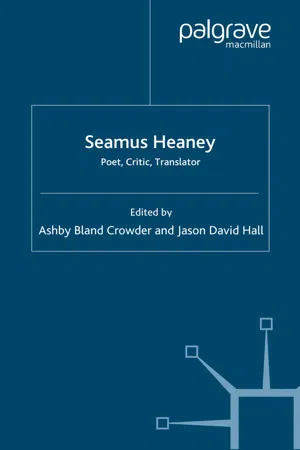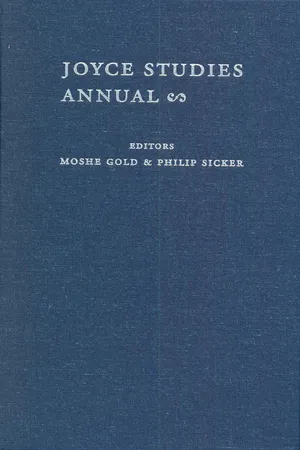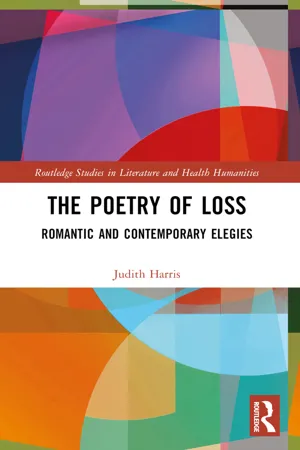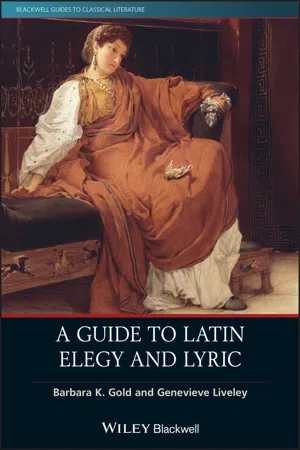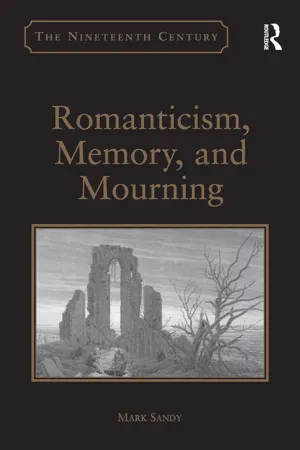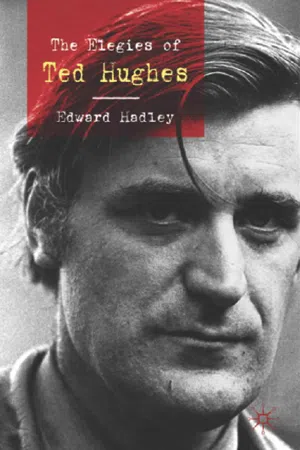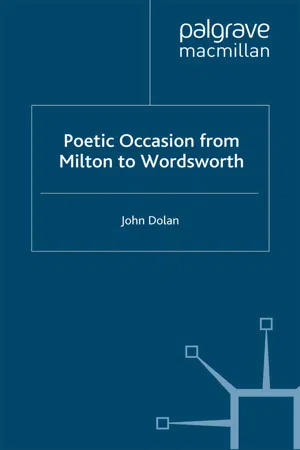Literature
Elegy
An elegy is a poem or song that expresses sorrow or lamentation, often for someone who has died. It typically reflects on the transience of life and the emotions of loss and grief. Elegies are characterized by their mournful and reflective tone, and they are a common form of expression in literature and music.
Written by Perlego with AI-assistance
12 Key excerpts on "Elegy"
- eBook - PDF
Seamus Heaney
Poet, Critic, Translator
- J. Hall, A. Crowder, J. Hall, A. Crowder(Authors)
- 2007(Publication Date)
- Palgrave Macmillan(Publisher)
The Elegy is a song of lamentation for the dead, usually mourning the loss of a personal friend or a public figure, though sometimes offering a melancholic reflection on a lost way of life. Thomas Gray’s ‘Elegy in a Country Churchyard’ does not address the loss of any particular indi- vidual, but it remains one of the best-known elegies in English. Throughout the history of English poetry there has been a strong tradi- tion of elegiac writing with its roots in the pastoral elegies of Greek 9 and Latin writers such as Theocritus and Virgil. Many of the classical conventions of Elegy are retained in familiar examples of the genre from John Milton’s ‘Lycidas’ to Matthew Arnold’s ‘Thyrsis’, including the summoning of the muses, the picking of flowers for consolation, and the longing for some kind of redemption or resurrection for the dead one. Recent theorists of Elegy have shown how generic conventions are repeatedly tested and modified over time, but have also raised important questions about the adequacy of elegiac poetry in an age of widespread scepticism and disbelief. Sacks, in The English Elegy: Studies in the Genre from Spenser to Yeats (1985), asks what happens to the conventions of the Elegy when modern writers and readers become sceptical of ‘the inherited means of consolation’. W. D. Shaw, in Elegy and Paradox: Testing the Conventions (1994), similarly asks ‘how far the consolations of a life-and-death art, of a poetry of loss, can be made to seem reason- able, even compelling, to readers living now, in our own time and place’. 3 Nevertheless, both critics acknowledge that elegies will continue to be written and read as long as there is a need among writers and readers to confront the pain and bewilderment of death. Although Sacks writes specifically about the English Elegy, the subti- tle of his book ought to alert us to the suggestion that there might be other national versions of Elegy. - eBook - PDF
- Philip T. Sicker, Moshe Gold, Philip T. Sicker, Moshe Gold(Authors)
- 2017(Publication Date)
- Fordham University Press(Publisher)
In The English Elegy , drawing on Freud’s famous essay of 1917 , “Mourning and Melancholia,” Peter Sacks describes the purpose of Elegy with reference to Freud’s notion of the “work” of mourning, identifying the typical Elegy with a “dynamic sense of the working through of an impulse or experience.” 7 Poetic form— including meter, rhyme, and other conventions of the genre—is a power-ful agent in the ceremony of grief and recovery. As Christine Froula puts it, “The poetic Elegy submits mourning’s formidable psychic turbulence to the rigorous formal mechanics of elegiac temporality.” 8 In its typical form, the Elegy is distinctive not only for its movement toward emotional wholeness but also for its value as an especially fine memento or keepsake. The poet, according to Jahan Ramazani, citing “Lycidas,” “finds recompense . . . in making this very poem” and in “redi-recting his affection from the lost friend to the brilliant artifact that is in some measure a replacement for the man it mourns.” 9 According to Sacks, however, even as it mourns the death of a particular person, the Elegy is self-reflexive, expressing sorrow for the poet’s own mortality, for lost youth, and, ultimately, for the first and most bitter of losses, that of the mother, “an inescapably recapitulated element of any mourning” ( 99 ). Milton’s “Lycidas,” a pastoral Elegy written on the death of Edward King 132 timothy martin and the subject of several allusions early in Ulysses , may be regarded as an early prototype of the more modern form. Among the best known exam-ples of this type of modern Elegy are Shelly’s Adonais , written on the death of Keats; Tennyson’s In Memoriam , on the death of the poet’s friend Arthur Hallam; and Walt Whitman’s “When Lilacs Last in the Dooryard Bloomed,” on the assassination of Abraham Lincoln. The elegiac poem, considered as a kind of artifact, is a gesture toward permanence, more lasting than a tombstone, more tangible than the promise of heaven. - eBook - PDF
Old English Poetry: An Anthology
A Broadview Anthology of British Literature Edition
- R.M. Liuzza, R.M. Liuzza, Joseph Black, Leonard Conolly, Kate Flint, Isobel Grundy, Don LePan, Jerome J. McGann, Anne Lake Prescott, Barry V. Qualls, Claire Waters(Authors)
- 2014(Publication Date)
- Broadview Press(Publisher)
All these titles, it must be remembered, are modern inventions, and not always the most reliable guides to the content or meaning of the poem. Like-wise the modern label “Elegy” is potentially misleading: in Greek and Latin literature the term refers to a particular metrical form, and since the sixteenth century the word has been used in English literature to describe a poem of mourning (the most famous ex-amples of classic English elegies include Milton’s Lycidas , Shelley’s Adonais , and Tennyson’s In Memoriam ). But the term “Elegy” is sometimes used more loosely to describe any serious meditative lyric poem, and it is in this broad sense that these Old English poems should be considered “elegies,” and can be read and studied together. The Old English elegies are not grouped together in the Exeter Book and are all, as far as we know, by different authors, but they share certain themes and concerns—the passage of time and the transience of earthly things, the pain of exile and separation, the ache of absence and longing—as well as certain images and scenes such as ruined or abandoned buildings, desolate landscapes, storms at sea, darkness, and the chill of winter. These themes, and the tra-ditional language in which they are presented, are found in other Old English poems—certain passages of Beowulf are “elegiac,” if not outright “Elegy”—and the contemplation of earthly mutability sometimes seems almost obsessive in Old English literature. The tone and language of Elegy may have roots deep in the traditions of Germanic poetry, but it is also influenced by late classical works such as Boethius’s Consolation of Philosophy ; the recognition that the world under the heavens is a place of tragic impermanence would probably have been regarded as equally good Christian doc-trine and worldly wisdom. - eBook - ePub
The Poetry of Loss
Romantic and Contemporary Elegies
- Judith Harris(Author)
- 2023(Publication Date)
- Routledge(Publisher)
Introduction The Elegiac Language and Expression of GriefDOI: 10.4324/9781003176510-1Samuel Johnson once said,Whether to see life as it is, will give us much consolation, I know not; but the consolation which is drawn from truth, if any there be, is solid and durable: that which may be derived from errour must be, like its original, fallacious and fugitive.From myths to dreams to the Bible itself, human grief utters a plaintive cry over the death of a loved one. This would seem inexpressible if not for the poet’s ultimate resolve to recover something from what has been lost. Writing and reading about death while living with it allows us to acknowledge how those we have lost continue to remain alive to us. They may have left us, but they endure within language, uniquely accessible and yet entirely unavailable except through image representation. No longer able to speak themselves into being, they rely on others to exist. Within this crucible of grief, the spirits of the dead appear paradoxically within the very words that claim they have vanished.Through aesthetic engagement with language, the elegiac poet summons images of death and regeneration from past, present, and future, ostensibly to offer consolation and a path forward following the loss of a loved one. However, contemporary critics are rethinking the ends of Elegy and presenting a theory of mourning extending beyond consolation. This concept challenges the Freudian assumption still prominent in some circles today that successful mourning comes to a decisive end when the mourner has detached emotionally from the deceased, investing instead in consoling and compensatory substitutes. The loss and gain model typifies conventional elegies seeking consolation but sharply differs from more turbulent modern and contemporary elegies, which eschew consolation in favor of continuing bonds with the deceased while accepting the sporadic, interminable disposition of mourning. But that which is “typical” in Elegy’s long-standing tradition has been changing. - eBook - ePub
- Katharina Volk(Author)
- 2011(Publication Date)
- Wiley-Blackwell(Publisher)
As it happens, Elegy is a kind of “catch-all” genre in Greek literature that is difficult to tie down to a particular topic, mood, or stylistic level – quite unlike, for example, epic, the high-style genre, written solely in hexameters, that was typically associated with narratives of heroic exploits. In the Archaic and Classical periods (7th–4th C. BCE), elegies were performed, accompanied by the flute, at the drinking parties (symposia) of the aristocracy. Subjects included rousing calls to battle, bitter-sweet reflections on love, and moralizing about the proper conduct expected of an upper-class male. At the same time, the elegiac couplet was used for short inscriptions, especially on gravestones or offerings to the gods. Such funerary or votive texts were called epigrams (Greek epigramma means “inscription”), and “epigram” subsequently became the term for any short poem in elegiacs, no matter whether it was really inscribed somewhere, imitated the inscriptional format as a kind of literary game (e.g., by producing a eulogy of a deceased person that was never in fact put on a gravestone), or made no such pretense and treated other topics entirely. Epigram is thus, as it were, Elegy’s little sister, with the demarcation between the two not always entirely clear (there is no fixed number of couplets that an epigram must reach to be considered an Elegy). Both Elegy and epigram flourished in the Hellenistic period (3rd C. BCE onward). Elegies, including very long ones, were written on a wide variety of topics, with Callimachus’ Aetia (four books on the origins of obscure religious practices) one of the most famous examples. There was also a craze for epigram, which was now a purely literary genre that could be used to treat pretty much any subject - eBook - PDF
- Erik R. Seeman(Author)
- 2019(Publication Date)
- University of Pennsylvania Press(Publisher)
They orient us toward the many ways in which Elegy was deeply em-bedded in New England’s death rituals. And because so many elegies spoke to the dead or represented the voice of the deceased, they made supernatural communication a frequent topic of contemplation for mourners. This section traces the life course of Elegy, including birth, life, death, and afterlife. A cul-tural biography of Elegy, in short, provides a thick description of the central-ity of poetry—and communication with the dead—to New England’s death culture. 26 Elegy was born in death. Without death, of course, there would be no need for Elegy. Though an obvious point, it is worth lingering on for a moment, 52 Chapter 2 for it highlights the motivations and desires that animate Elegy. If poetry is a universal human art, Elegy is a particular expression of that universal form, responding to the rent in societal fabric caused by death and shaped by the mortuary culture of a specific society. As with any newborn, one can trace Elegy’s genealogy. For mourning poetry the lineage is long and distinguished. Perhaps the first Elegy in the Western canon is the biblical King David’s lament for Jonathan and Saul (2 Sam. 1:27). Funeral poetry was common in ancient Greece and Rome; verses frequently praised the deceased and lamented the person’s death. Renaissance interest in the classical world brought forth a revival of Elegy in Continental Europe and England. Although generalized poetic laments had long been a part of England’s literary culture, the personal Elegy—written to mark the death of an individual rather than to confront mortality or loss more generally—first appeared with this Renaissance rehabilitation of the form. After the Protestant Reformation, the tradition of English Elegy only grew in the variety of its styles and the diversity of its sources. 27 The puritan migration to New England narrowed Elegy’s gene pool both stylistically and in terms of subject matter. - eBook - ePub
- Barbara K. Gold, Genevieve Liveley(Authors)
- 2021(Publication Date)
- Wiley-Blackwell(Publisher)
However, early Elegy appears to have been associated in particular with short poems used as grave dedications and funeral epitaphs. The Roman love elegists like to remind us of this mournful connection between Elegy and death, and we often find death itself as a theme in their poetry. The Roman elegists also make much of two possible etymological roots of Elegy: the Greek word elegeia (λεγεα), which is derived from the traditional Greek funerary lament e e legein (λγειν) – to cry “woe, woe” – and from the related emotion eleos (λεος) pity. Ovid, in an Elegy written to commemorate the death of his elegiac predecessor Tibullus, draws an explicit etymological connection between Elegy and lamentation (Amores 3.9.3–4): Flebilis indignos, Elegia, solve capillos! A, nimis ex vero nunc tibi nomen erit. (Weep, Elegy, and let down your undeserving hair! Ah, it is all too true that your name comes from this.) Horace too declares in his Ars Poetica that: “the foremost theme of poetry in elegiac couplets is lament” (75–6). This connection between Elegy and the theme of lament was a longstanding ancient tradition, then, and the Roman elegiac poets use it as a means to add themselves to an elegiac canon of such poetry stretching back hundreds of years. One of the first elegiac poets, the fifth century bce Greek poet Antimachus (writing around 400 bce) was famous for his Lyde, an elegiac memorial to his dead mistress – now lost but apparently filled with “lamentations” and “full of unhappy heroic stories” (Hermesianax fr. 7/45). The Greek poet Philitas wrote a similar collection of elegiac poems memorializing his dead wife (or possibly his mistress) Bittis. And the poet Hermesianax followed this trend, with a collection of poems dedicated to and named after his mistress Leontion - eBook - PDF
Greek Elegy and Iambus
A Selection
- William Allan(Author)
- 2019(Publication Date)
- Cambridge University Press(Publisher)
Despite the modern (Romantic-period) idea of ‘lyric’ as a single form encompassing lyric (both solo and choral), Elegy, and iambus, it makes sense to see them as distinct genres, even if the boundaries between them are fluid. On definitions of ‘lyric’, ancient and modern, see Budelmann 2018: 2–4. 2 On various aspects of Elegy, see West 1974: 1–21, Adkins 1985, Herington 1985: 192–3, Bowie 1986, 1990, 2016b, Fowler 1987: 86–103, Bartol 1993: 18–30, 46–60, Gerber 1997b, Kurke 2000: 54–7, Irwin 2005: 19–111, Aloni and Iannucci 2007: 3–108, Faraone 2008, Garner 2011, Lulli 2011, Budelmann and Power 2013, Swift and Carey 2016. 3 See the headnote to Theognis in the commentary. 2 INTRODUCTION work (for the former’s historical Elegy, see Tyrt. 5–7*; for the latter’s myth- ological narrative, see Mimn. 12*). The variety of early Elegy is potentially further obscured by the form’s association with mourning and lamentation. By the late fifth century the term ἔλεγος was used to describe songs of mourning (e.g. Eur. Tro. 119, Hel. 185, IT 146), and later writers frequently connected Elegy with grief or claimed that Elegy originated in lament (e.g. Hor. Ars P. 75 uersibus impariter iunctis querimonia primum). However, the surviving examples of Archaic Elegy tell a different story, since only a few have anything to do with mourning (e.g. Archil. 13*, Simonides’ Plataea Elegy*). So unless a whole foundational tradition of lamentatory Elegy has vanished without trace, 4 the particular association of Elegy with mourning is likely to be due to a later narrowing of the genre, akin to the narrowing definition of iambus as invective poetry evident from the fifth century onwards (see below). Although Elegy was deployed for laments and funerary epitaphs in the Archaic period, this was only one aspect of its use. - eBook - ePub
- Mark Sandy(Author)
- 2016(Publication Date)
- Routledge(Publisher)
15_______________14 For a detailed account of those conventional and revisionary aspects of the Elegy as genre, see Peter M. Sacks, The English Elegy: Studies in the Genre from Spenser to Yeats (London; Baltimore: Johns Hopkins UP, 1985 ), p. xiii; pp. 1–37. Hereafter PME.15 This study in spirit has an affinity with Stuart Curran's sense of form and genre in poetry of the period. See Curran, Poetic Form and British Romanticism (London; New York: Oxford UP, 1986 ), p. 13. David Duff suggests that ‘the Romantic Period … experienced not so much a dissolution of genres as a consolidation of and commodification of them’ (p. 6). See Duff, Romanticism and the Uses of Genre (Oxford: Oxford UP, 2009 ).II
If Romantic writers are, as Shelley claims, ‘the mirrors of the gigantic shadows which futurity casts upon the present’,16 then these grief-stricken instances of mourning – which often form the occasion for poetry – are as much regretful retrospection as they are, inextricably, bound up with the futures that they imaginatively project for the living and the dead. Romanticism's fascination with these imagined afterlives finds expression in its anxiety over an envisaged future audience and reception as well as its reflections on what it means to live posthumously and write for posterity. By identifying the Romantic artist with those who desire a posthumous existence, Shelley's claim suggestively aligns his fellow Romantics with Nietzsche's chosen few who ‘are born posthumously.’17 In spite of the notorious anti-Romantic tenor of much of his philosophy, Nietzsche's description of this posthumous birth ‘after we have died’, written for the second edition of The Gay Science - eBook - PDF
- E. Hadley(Author)
- 2010(Publication Date)
- Palgrave Macmillan(Publisher)
Accordingly, the precepts of Elegy that were once abundant have, in the twentieth century, declined and become inconsistent. R. Clifton Spargo observes that a number of poets (including Whitman, Hardy, Introduction 3 Yeats, Eliot and Stevens) ‘invoke pastoral scenes, almost perhaps as a poetic reflex, but with perceptibly diminished expectations about the consolations they will offer’. 9 The idea of a pastoral idyll seems not only archaic, but seriously inappropriate. John Vickery notes: Loss of life, of course, continues to play a central role in the elegiac imaginations. But to it have been added losses in cultures and civilisations … dissolutions of the family and families … changes and concomitant losses in personal relations such as romantic love and marriage … intellectual excisions and reconfigurations of philosophical notions such as time … and self … and efforts to assess the contemporary nature and value of war. Each of these has occasioned profound elegiac attitudes ranging from regret, sorrow, confusion, and alienation to outright despair. 10 The cumulative effect of such despairs has borne the sub-genre of ‘anti-Elegy’, whose characteristics are prominent in modern Elegy. Spargo writes of: Locating anti-Elegy in the modern moment when the Elegy takes a turn against itself and begins to doubt the literary conventions for redeeming grief as well as the broader sociophilosophical possibility of consolation … wherein the emphasis falls to the anti- consolatory, nontranscendent perspective of modern grief – resists literary and social conventions, it traces implicitly the survival of grief against a social totality that denies the dead. - eBook - PDF
- J. Dolan(Author)
- 1999(Publication Date)
- Palgrave Macmillan(Publisher)
In the seventeenth-century literary context, the best Elegy was one which would satisfy both the desire to shine and the need to fulfil one's social obligations: 'a poem or a speech ... [which would] outlive its moment and audience and yet remain within its occasion as well'. (Sloane, 57) A poem which transcended its occasion too obviously would be seen as a mere vehicle of ambition. Were the poets who contributed to memorial volumes of the mid-seven- teenth century aware of this problem? Did they worry about it? A persistent accusation about 'Lycidas' (the only poem of JEK II which is still widely read) touches on this question. The accusation is that in 'Lycidas' Milton unscrupulously exploited the death of Edward King, for whom he really cared little. Samuel Johnson, in an oft-quoted passage from his Life of Milton, seems to accuse Milton of exploiting an acquaintance's death: ['Lycidas'] is not to be considered as the effusion of real passion; for passion runs not after remote allusions and obscure opinions. Passion plucks no berries from the myrtle and ivy, nor calls on Arethuse and Mincius, nor tells of rough satyrs and fauns with cloven heel. Where there is leisure for fiction there is little grief. (Chalmers, 7: 302) Johnson's accusation of insincerity has been many times repeated, and as many times dismissed as unfair and anachronistic. Defenders of the poem have either tried to prove that Milton and King really were friends, or have argued that the rules governing Elegy in seventeenth-century English literary culture did not require that the poet feel anything like 'sincere' grief. 34 Poetic Occasion from Milton to Wordsworth Both arguments are alive and well. A recent edition of works related to Justa Edovardo King argues for Milton's sincerity, devoting considerable effort to proving that Milton and King really were friends. - eBook - PDF
The Narratological Analysis of Lyric Poetry
Studies in English Poetry from the 16th to the 20th Century
- Peter Hühn, Jens Kiefer, Alastair Matthews(Authors)
- 2011(Publication Date)
- De Gruyter(Publisher)
6 Lyric-Specific Features One feature of the narrative composition of Gray's 'Elegy' that is specific to lyric poetry (and particularly that of the Romantic period, as anticipated here by Gray's pre-Romanticism) is the paradoxical combination of narra-tive self-reflexivity and self-definition. The self defines and identifies itself by narrating its own emotional behaviour and psychological devel-opment, but does so while simultaneously concealing this self-referential-ity. A second lyric-specific feature, which completes and confirms the first, lies in the fact that narration takes place from within a story that has not reached closure. Death, the future end of the narrative of a life, is nar-rated prospectively, yet it is also the only temporal position from which the definitive meaning of a life story can be narrated without the potential for later revision. It is also the only point from which the type of story represented by the life in question can be reliably and conclusively deter-mined (cf. Benjamin 1977; Brooks 1984:22-34). By narrating from a po-sition within the course of his own life, then, the speaker is prospectively anticipating retrospection and trying to determine the form that his life will ultimately be seen to have taken. In this way, he hopes to stabilize his identity in the present by narrating the future. 13 Cf. the general emphasis placed by McCarthy (1997:15), albeit with a less specific explanation, on uncertainty as a product of the poem's end. Cf. also Newey (1993), who reveals the generally precarious status of the composition of identity in Gray's poem. Gray: Elegy Written in a Country Churchyard 93 In so far as the speaker's narrative of his life is self-referentially tied to the poem, the narrative stabilization of identity in Thomas Gray's 'Elegy Written in a Country Church Yard' resembles the strategy employed in Shakespeare's Sonnet 107, Swift's 'Verse on the Death of Dr.
Index pages curate the most relevant extracts from our library of academic textbooks. They’ve been created using an in-house natural language model (NLM), each adding context and meaning to key research topics.
